2017 MERCEDES-BENZ S-CLASS CABRIOLET tow
[x] Cancel search: towPage 42 of 521
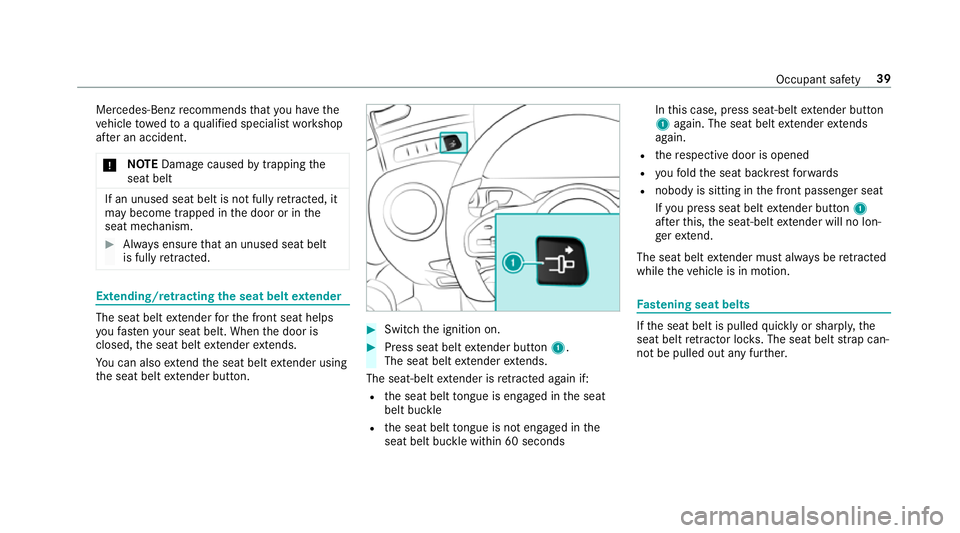
Mercedes-Benzr
ecommendsthat youh avet he
ve hicle towe dtoaq ualified specialis tworks hop
af te rana ccident.
* NO
TEDama gecaused bytrapping the
seat belt If an unused seat belt is no
tfully retracted ,it
ma ybecome trappe dinthe door or in the
seat mechanism. #
Alw ayse nsur ethat an unused seat belt
is full yretra cted. Ex
tending/r etra ctin gthe sea tbelt extender The seat belt
extende rfor thef ront seat helps
yo uf asteny our seat belt. When thed oor is
closed, thes eat belt extende rextends.
Yo uc an also extend thes eat belt extende rusing
th es eat belt extende rbutton. #
Switc hthe ignition on. #
Press seat belt extende rbutton 1.
The sea tbelte xtende rextends.
The seat-belt extende risr etra cted agai nif:
R thes eat belt tongu eise ngaged in thes eat
belt buckle
R thes eat belt tongu eisn otengaged in the
seat belt buckle within 60 seconds In
this case, press seat-belt extende rbutton
1 again. The sea tbelte xtende rextends
again.
R ther espectiv edoor is opened
R youf old thes eat backres tfor wa rds
R nobody is sittin ginthe front passenger seat
If yo up ress seat belt extende rbutton 1
af te rt his, thes eat-belt extende rwillnol on‐
ge re xtend.
The sea tbelte xtende rmusta lway sber etra cted
whil ethe vehicle is in motion. Fa
stening seat belts If
th es eat belt is pulled quickl yors harply,the
seat belt retractor lo cks. The seat belt stra pc an‐
no tbep ulled out an yfurther. Occupant saf
ety39
Page 45 of 521
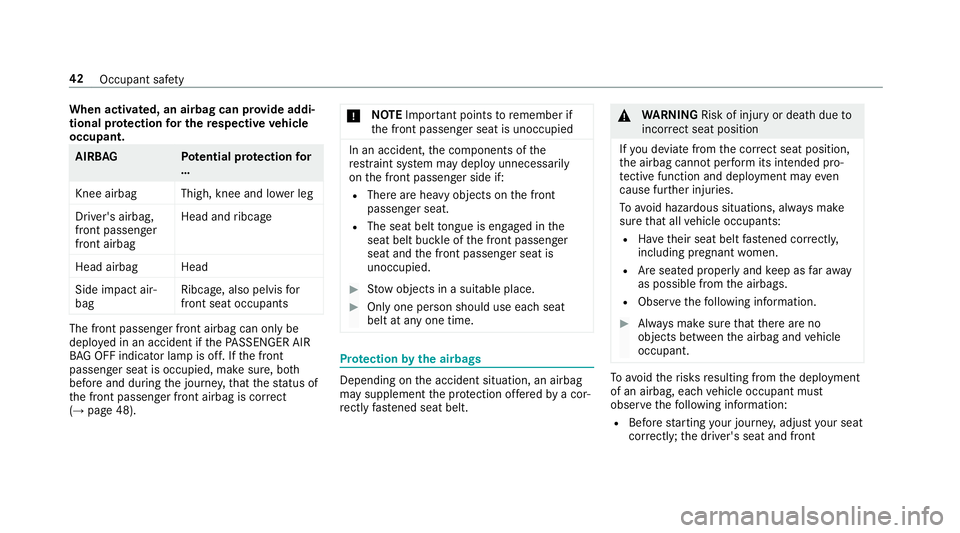
When activated, an airbag can pr
ovide addi‐
tiona lprotection fort he respectiv evehicle
occupant. AIRB
AG Potentia lprotection for
…
Knee airbag Thigh ,knee and lo werleg
Driver's airbag,
front passenger
front airbag Head and
ribcage
Head airbag Head
Side impact air‐
bag Ribcage, also pelvis
for
front sea toccupants The front passenger front airbag can onl
ybe
depl oyed in an acciden tifthePASSENGER AIR
BA GO FFindicator lam pisoff.Ift he front
passenger seat is occupied, mak esure, bo th
befor eand during thej ourne y,that thes tatus of
th ef ront passenger front airbag is cor rect
(→ page 48). *
NO
TEImpo rtant points toremember if
th ef ront passenger seat is unoccupied In an accident,
thec omponents of the
re stra int sy stem ma ydeplo yunnecessarily
on thef ront passenger side if:
R Ther eareheavy objects on thef ront
passenger seat.
R The seat belt tongu eise ngaged in the
seat belt buckle of thef ront passenger
seat and thef ront passenger seat is
unoccupied. #
Stow object sinas uitable place. #
Onlyone person should use eac hseat
belt at an yone time. Pr
otection bythea irbags Depending on
thea cciden tsituation ,anairbag
ma ysupplement thep rotection of fere dbyac or‐
re ctly fastened seat belt. &
WARNING Risk of inju ryor deat hdueto
incor rect sea tposition
If yo ud eviat ef romt he cor rect sea tposition,
th ea irbag cann otper form its intended pro‐
te ctiv efunction and deployment ma yeven
cause fur ther injuries.
To avo id hazardous situations ,alway sm ake
sur ethat all vehicle occupants:
R Have their seat belt fastened cor rectly,
including pregnant women.
R Ares eated properly and keep as fara way
as possible from thea irbags.
R Obser vethef ollowing information. #
Alw aysm akes uret hat ther ea reno
objects between thea irbag and vehicle
occupant. To
avo idther isk sresulting from thed eployment
of an airbag, eac hvehicle occupant must
obser vethef ollowing information:
R Befor estartin gy our journe y,adjus tyour seat
cor rectly ;the driver's seat and front 42
Occupant saf ety
Page 46 of 521
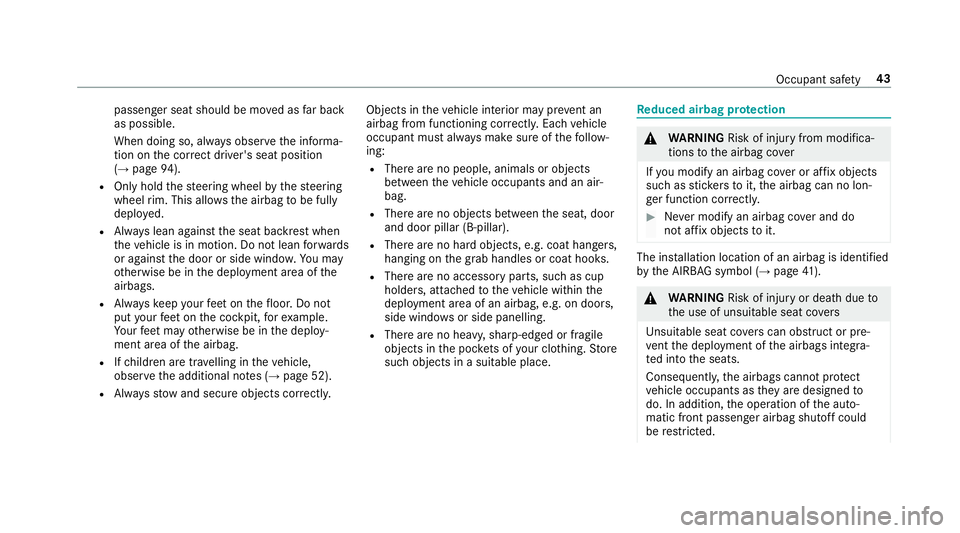
passenger seat should be mo
vedasf ar back
as possible.
When doing so, alw ayso bser vethei nforma‐
tion on thec orrect driver's sea tposition
(→ page 94).
R Onlyhold thes teering wheel bythes teering
wheel rim. This allows thea irbag tobe fully
deplo yed.
R Alw aysl ean agains tthe seat backres twhen
th ev ehicle is in motion. Do no tlean forw ards
or agains tthe door or side windo w.Youm ay
ot herwise be in thed eployment area of the
airbags.
R Alw aysk eep your feet on thef loor .Don ot
put your feet on thec ockpit, fore xamp le.
Yo ur feet ma yotherwise be in thed eploy‐
ment area of thea irbag.
R Ifch ildren ar etrave lling in thev ehicle,
obser vethea dditional no tes( → pag e52).
R Alw ayss towa nd secur eobject scorrectl y. Objects in
thev ehicle interior ma ypreve nt an
airbag from functioning cor rectl y.Eac hvehicle
occupant mus talway sm akes ureoft hefollow‐
ing:
R Ther eareno people, animals or objects
between thev ehicle occupants and an air‐
bag.
R Ther eareno objectsb etwe en thes eat, door
and door pillar (B-pillar).
R Ther eareno har dobjects, e.g. coat hangers,
hanging on theg rabh andles or coat hooks.
R Ther eareno accessor yparts, suc hascup
holders, attached tothev ehicle within the
deployment area of an airbag, e.g. on doors,
side windo wsor side panelling.
R Ther eareno heavy ,sharp-edged or fragile
object sinthe poc kets of your clo thing. Store
suc hobjectsinas uitable place. Re
duce dairbag pr otection &
WARNING Risk of inju ryfrom modi fica‐
tions tothea irbag co ver
If yo um odify an airbag co verora ffix objects
suc hass tickers to it,thea irbag can no lon‐
ge rfunction cor rectl y. #
Neverm odify an airbag co vera nd do
no ta ffix objectstoi t. The ins
tallation location of an airbag is identified
by theA IRB AG symbol (→ page41). &
WARNING Risk of inju ryor deat hdueto
th eu se of unsuitable seat co vers
Uns uitable seat co vers can obstruct or pre‐
ve nt thed eployment of thea irbags integra‐
te di ntot he seats.
Consequentl y,thea irbags cann otprotect
ve hicle occupants as they ared esigned to
do. In addition, theo peration of thea uto‐
matic front passenger airbag shutof fcould
be restricted. Occupant saf
ety43
Page 47 of 521

#
Yous hould on lyuse seat co vers that
ha ve been appr oved fort he cor respond‐
ing seats byMercedes-Benz. &
WARNING Risk of inju rydue tomalfunc‐
tions of thes ensor sinthe door panelling
Sensor stocontrol thea irbags ar elocated in
th ed oors. Modification sorworkn otper‐
fo rm ed cor rectl ytot he door sordoor panel‐
ling, as well as damaged doors, can lead to
th ef unction of thes ensor sbeing impaired.
The airbags might therefor enotfunction
proper lyan ym ore.
Consequent ly,t he airbags canno tprotect
ve hicle occupants as they ared esigned to
do. #
Neverm odify thed oor sorp arts of the
doors. #
Alw aysh ave workon thed oor sord oor
panelling car ried out at aqualified spe‐
cialis tworks hop. &
WARNING Risk of inju rydue todeplo yed
airbag
Ad eplo yeda irbag no longer of fers anyp ro‐
te ction and canno tprovide thei ntended pro‐
te ctiv efunction in thee vent of an accident. #
Have thev ehicle towe dtoaq ualified
specialis tworks hop in order tohave the
deplo yeda irbag replaced. Ha
ve deplo yeda irbags replaced immediately. St
atus of thef ront passenger airbags Fu
nction of thea utomatic front passenger
front airbag deactivation sy stem
The automatic front passen gerfront airbag deac‐
tivation sy stem is able todetect whe ther the
front passenger sea tisoccupied byap erson or
ac hild restra int sy stem. The front passenger air‐
bag is enabled or disabled accordingly. When
fitting achild restra int sy stem tothef ront
passenger seat, alw aysm akes ureoft hefollow‐
ing:
R Ensur ethat thec hild restra int sy stem is posi‐
tioned cor rectl y(→pag e59).
R Alw ayso bser vethec hild restra int sy stem
manufacturer's ins tallation instructions.
R Neverp lace objects, e.g. cushions, under or
behind thec hild restra int sy stem.
R Fullyr etra ct thes eat cushion lengt hadjust‐
ment.
R The entir ebase of thec hild restra int sy stem
mus talway sr estont he sitting sur face of the
front passenger seat.
R The backres toftheforw ard-facin gchild
re stra int sy stem must, as farasp ossible, be
re sting on thes eat backres tofthe front
passenger seat.
R The child restra int sy stem mus tnot to ucht he
ro of or be put under stra in by theh ead
re stra ints. Adjus tthe seat backres tinclina‐
tion and theh ead restra int setting accord‐
ing ly. 44
Occupant saf ety
Page 52 of 521
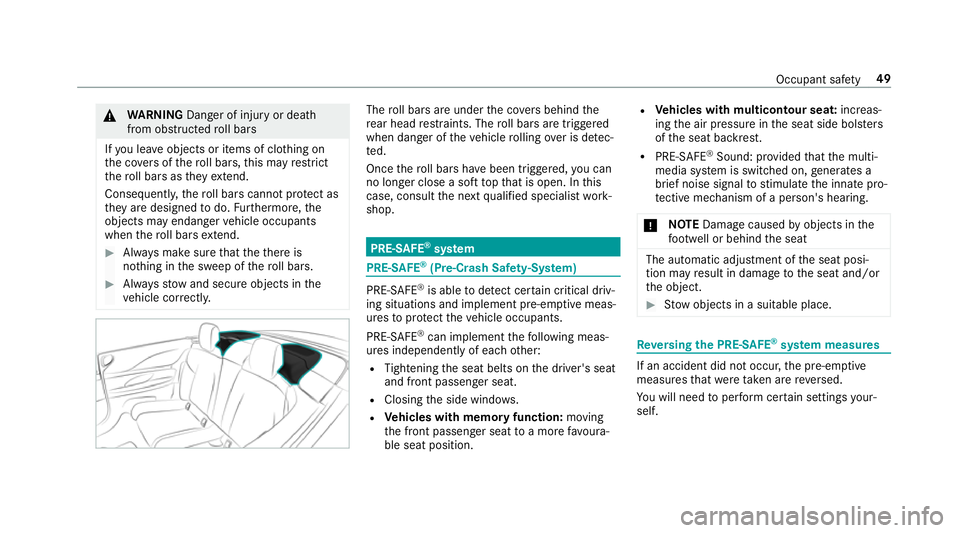
&
WARNING Danger of inju ryor death
from obstructed roll bars
If yo ul eave object soritems of clo thing on
th ec oversoft heroll bars, this ma yrestrict
th er oll bar sastheye xtend.
Consequently ,the roll bar scanno tprotect as
th ey ared esigned todo. Furthermore, the
object smayendanger vehicle occupants
when ther oll bar sextend. #
Alw aysm akes uret hat thet her eis
no thing in thes weep of ther oll bars. #
Alw ayss towa nd secur eobject sinthe
ve hicle cor rectl y. The
roll bar sareunder thec oversb ehind the
re ar head restra ints. The roll bar saretriggered
when danger of thev ehicle rolling overisd etec‐
te d.
Onc ethe roll bar shaveb een triggered, youc an
no lon gerc lose asoftt op that is open .Inthis
case, consult then extq ualified specialis twork‐
shop. PRE-SAFE
®
sy stem PRE-
SAFE®
(Pre-Crash Saf ety-Sy stem) PRE-
SAFE®
is able todetect cer tain critical driv‐
ing situations and implemen tpre-em ptivem eas‐
ures toprotect thev ehicle occupants.
PRE-SAFE ®
can implement thef ollowing meas‐
ures independentl yofeacho ther:
R Tightening thes eat belts on thed rive r's seat
and front passenger seat.
R Closing thes ide windo ws.
R Vehicles with memor yfunction: moving
th ef ront passenger seat toam oref avo ura‐
ble seat position. R
Vehicles with multicontour seat: increas‐
ing thea ir pressur einthe seat side bols ters
of thes eat backrest.
R PRE-SAFE ®
Sound: pr ovided that them ulti‐
media sy stem is switched on, generates a
brie fnoise signa ltostimulat ethe innat epro‐
te ctiv em echanism of aperson's hea ring.
* NO
TEDama gecaused byobject sinthe
fo ot we ll or behin dthe seat The automatic adjustment of
thes eat posi‐
tion ma yresult in damag etothe seat and/or
th eo bject. #
Stow object sinas uitable place. Re
versing theP RE- SAFE®
sy stem measures If an acciden
tdid no toccur ,the pre-em ptive
measures that we retak en ar ereve rsed.
Yo uw ill need toper form certain settings your‐
self. Occupan
tsafety 49
Page 69 of 521

#
Todeactivate: pressthe& button on the
ke yt wice in rapid succession.
The batter ychec klam poft hekeyf lashes
twic ebrief ly and light suponce. #
Toactivate: press anybutton on thek ey.
% When thev ehicle is star tedw itht he keyin
th es towa ge compartment of thec ent recon‐
sole, thek eyfunction sareautomatical ly
activated (→ page143). Re
moving/insertin gthe eme rgency key #
Toremo ve: press release knob 1.
Emer gency key2is pushed out slight ly. #
Pull out emer gency key2until it en gage sin
th ei ntermediat eposition.
% Youc an use thei ntermediat eposition of
emer gency key2toattac hthe keytoak ey
ri ng. #
Press release knob 1again and fully
re mo veemer gency key2. #
Toinser t:press release knob 1. #
Inser temer gency key2tothei ntermediate
position or full yuntil it engages. Re
placing the keyb attery &
DANG ER Serious damag etohealth
caused byswallowing batteries
Batteries contain toxic and cor rosiv es ub‐
st ances. Swallowing bat teries ma ycause
serious damag etohealth.
Ther eisar isk offata linjur y. #
Keep batteries out of ther eac hofc hil‐
dren. #
If batteries ar eswallowe d, seek medical
attention immediately. +
ENVIRONMEN
TALN OTE Environmental
dama gedue toimproper disposal of bat‐
te ries Batteries conta
in pollutants. It is
illegal todispose of them wit hthe household
ru bbish. #
Dispose of batteries in an
environmen tallyr esponsibl emanner.
Ta ke dischar gedb atteries toaq ualified
specialis tworks hop or toac ollection
poin tfor used batteries. Re
quirements:
R Your equir eaCR2 0323Vc ell batter y. 66
Openin gand closing
Page 75 of 521
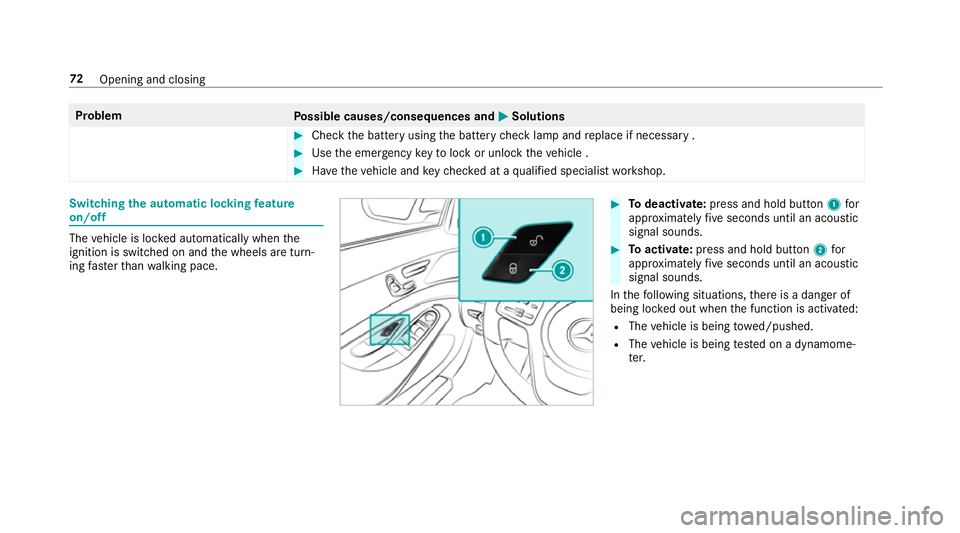
Problem
Possible causes/consequences and M
MSolutions #
Chec kthe batter yusing theb atter ychec klam pand replace if necessar y. #
Use thee mer gency keytol ockoru nlockthe vehicle . #
Have thev ehicle and keyc hec kedataq ualified specialis tworks hop. Switching
thea utomatic locking feature
on/off The
vehicle is loc keda utomatically when the
ignition is switched on and thew heels ar eturn‐
ing fast erthan walkin gpace. #
Todeactivate: press and hol dbutton 1for
appr oximatel yfives econds until an acoustic
signal sounds. #
Toactivate: press and hold button 2for
appr oximatel yfives econds until an acoustic
signal sounds.
In thef ollowing situations, ther eisad anger of
being loc kedo ut when thef unction is activated:
R The vehicle is being towe d/pushed.
R The vehicle is being tested on adynamome‐
te r. 72
Opening and closing
Page 77 of 521
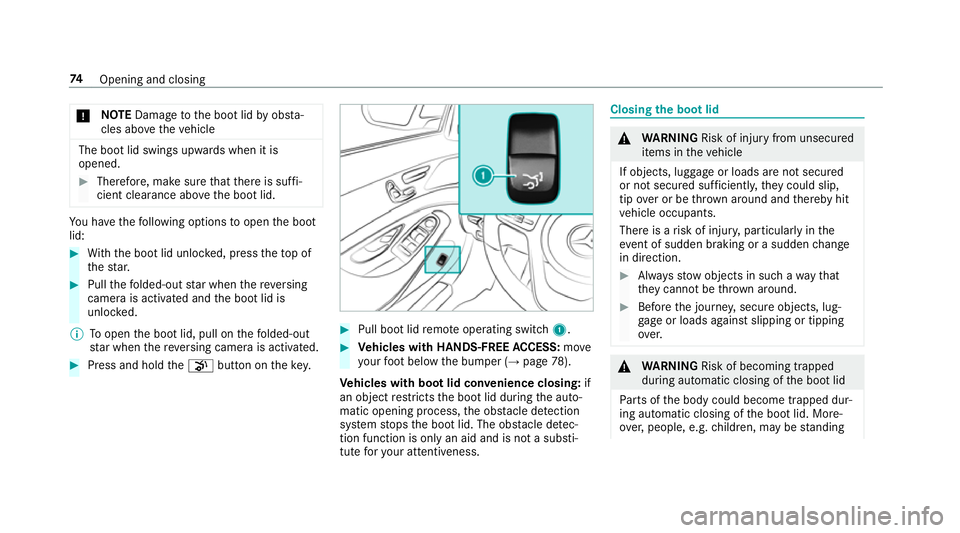
*
NO
TEDama getotheb ootlid by obs ta‐
cle sabove thev ehicle The boo
tlid swings upwards when it is
opened. #
Therefore, mak esuret hat ther eiss uffi‐
cient clearance ab ovetheb ootlid. Yo
uh ave thef ollowing options toopen theb oot
lid: #
With th ebootlid unloc ked, press thet op of
th es tar. #
Pull thef olded-out star when ther eve rsing
camera is activated and theb ootlid is
unloc ked.
% Toopen theb ootlid, pull on thef olded-out
st ar when ther eversing camera is activated. #
Press and hold thep button on thek ey. #
Pull boo tlid remo teoperating switch 1. #
Vehicles with HANDS-FREE ACCESS: move
yo ur foot belo wthe bumper (→ page78).
Ve hicles with boo tlid conve nience closing: if
an object restricts theb ootlid during thea uto‐
matic opening process, theo bstac le de tection
sy stem stops theb ootlid. The obs tacle de tec‐
tion function is only an ai dand is no tasubsti‐
tut efor your attentiveness. Closing
theb ootlid &
WARNING Risk of inju ryfrom unsecu red
items in thev ehicle
If objects, luggag eorloads ar enotsecured
or no tsecured suf ficientl y,they could slip,
tip ove rorbet hrow na roun da nd thereb yhit
ve hicle occupants.
Ther eisar isk of inju ry,p articularly in the
ev ent of sudden braking or asudden change
in direction. #
Alw ayss towo bjectsins uchaw aythat
th ey canno tbethrow na round. #
Befor ethe journe y,secur eobjects, lug‐
ga ge or loads agains tslipping or tipping
ove r. &
WARNING Risk of becoming trapped
du ring au tomatic closing of theb ootlid
Pa rtsoft he body could become trapped dur‐
ing automatic closing of theb ootlid. More‐
ove r,people, e.g. children, ma ybestanding 74
Opening and closing